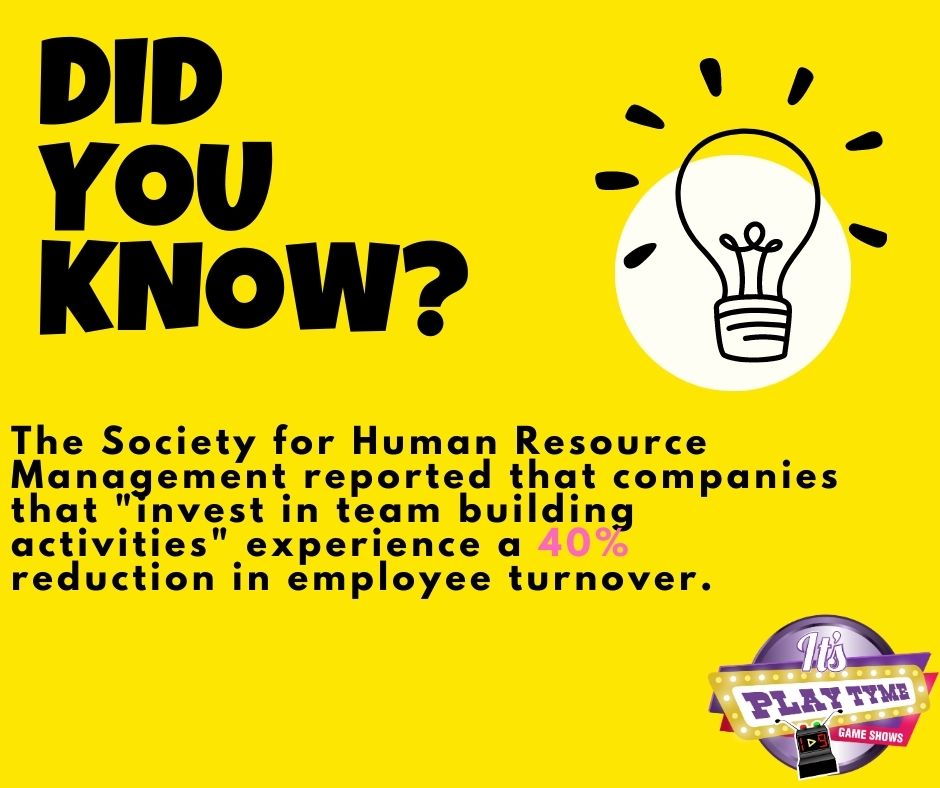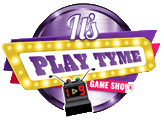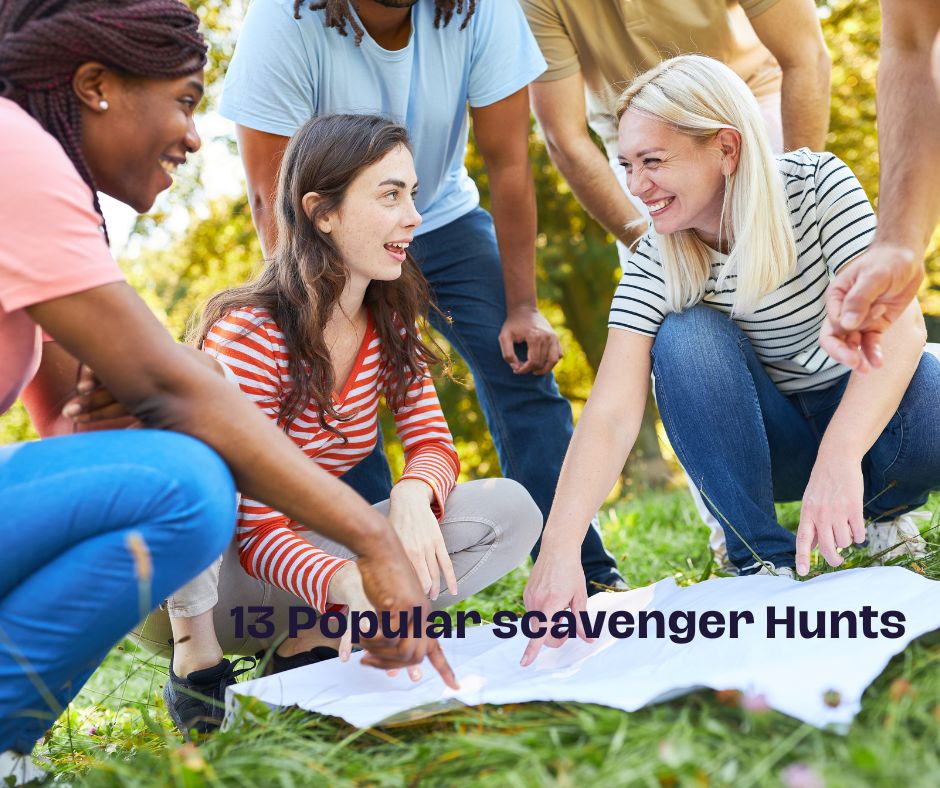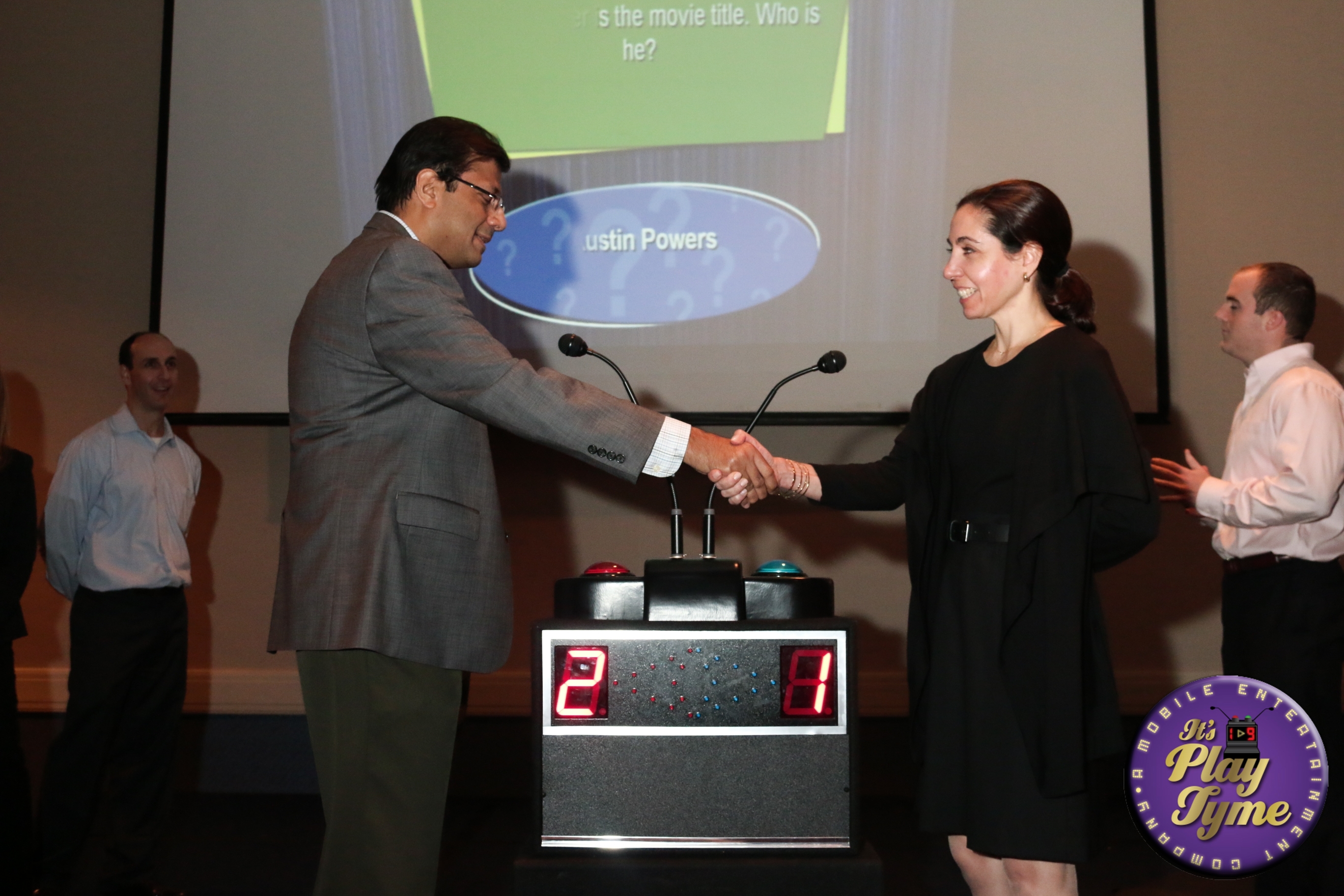Step into the world of teamwork with our “13 Popular Scavenger Hunt Ideas for Successful Teams.”
In this blog, we’re diving into some seriously cool ideas that’ll make teamwork a blast. Imagine the fun of working together, the thrill of adventure, and the satisfaction of nailing challenges.
Whether you’re the team leader looking to spice things up or just someone who wants to have a blast with your colleagues, these scavenger hunt ideas are the key to turning ordinary teamwork into something epic.
Get ready to learn the secrets of building successful teams as we explore these awesome adventures.
.jpg)
Scavenger hunts are a fantastic way to foster teamwork and camaraderie among employees or groups.
They’re not just a fun way to spend an afternoon, but they also help to develop essential skills like communication, problem-solving, and collaboration.
So, if you’re looking for a unique and engaging team-building activity, why not consider organizing a scavenger hunt?
12 Steps to Organize a Scavenger Hunt
Organizing a scavenger hunt requires careful planning and attention to detail.
It involves creating a list of items or tasks, establishing rules, setting boundaries, and assigning teams.
Also, ensure the safety and enjoyment of participants by providing clear instructions and monitoring the progress.
To organize a successful scavenger hunt, follow these simple steps:
- Set objectives: Determine the purpose of the scavenger hunt and what you want participants to achieve.
- Choose a theme: Choose a theme that adds excitement and ties into your objectives.
- Pick the location: Pick a location that is suitable for your theme and offers various hiding spots for clues.
- Design clues: Create clues that are challenging but solvable, and align with your theme.
- Prepare materials: Gather all the materials you need, such as clue cards, pens, and prizes.
- Set rules: Establish rules and communicate them clearly to all participants before the scavenger hunt begins.
- Form teams: Divide participants into teams, ensuring a mix of skills and abilities in each team.
- Provide instructions: Explain the rules, objectives, and instructions to all participants at the start of the scavenger hunt.
- Start the hunt: Release the teams to begin their search and solve the clues to progress.
- Monitor progress: Keep track of each team’s progress and provide support or hints as needed.
- Celebrate the winners: Once all teams have completed the hunt, announce the winners and award the prizes.
- Debrief and reflect: Gather participants for a debriefing session to discuss their experiences and any improvements for future hunts.
What Are the Benefits of Scavenger Hunts for Team Building?

Employee turnover
- Enhances teamwork and collaboration: Scavenger hunts require teams to work together, communicate effectively, and support one another to complete tasks and solve clues.
- Improves problem-solving skills: Teams must think critically, analyze clues, and strategize to successfully navigate the scavenger hunt.
- Promotes creativity and innovation: Scavenger hunts often involve creative challenges, stimulating teams to think outside the box and come up with unique solutions.
- Bonds team members: By participating in a fun and exciting activity, team members develop a stronger sense of camaraderie and build meaningful connections.
- Increases motivation and engagement: Scavenger hunts spark enthusiasm and excitement among team members, boosting their energy and drive to actively participate.
- Develops effective communication: Teams must communicate clearly and efficiently to coordinate their efforts, share information, and achieve common goals.
- Fosters leadership skills: Scavenger hunts provide opportunities for individuals to take on leadership roles, make decisions, and guide their teams towards success.
1 – Classic Photo Scavenger Hunt
- A Classic Photo Scavenger Hunt is a fantastic and interactive activity that can genuinely bring teams together and cultivate a sense of camaraderie.
Here are some suggestions for planning purposes:
- Create an inventory of specific objects or landmarks that participants must capture in photos, such as a street sign, a statue, or a renowned landmark.
- Include challenges that prompt participants to take imaginative or amusing photos, like posing in ridiculous outfits or reenacting scenes from well-known movies.
- Time Limit: To add an element of thrill and urgency, establish a time limit for the scavenger hunt.
- Motivate participants to collaborate and strategize in order to optimize their chances of photographing all the items on the list.
- Offer a prize to the team that accomplishes the most challenges or produces the most creative photos.
Go, grab your camera and prepare to capture some indelible moments with your teammates!
2 – Nature Scavenger Hunt
- Location, location, location: When organizing a Nature Scavenger Hunt, select a natural area such as a park, forest, or beach where participants can explore and find items on their list.
- Create a list: Compile a list of items related to nature that participants need to find during the Nature Scavenger Hunt. This can include specific plants, animals, natural objects, or environmental features.
- Assign teams: Divide participants into teams to encourage collaboration and competition during the Nature Scavenger Hunt.
- Provide instructions: Explain the rules and objectives of the Nature Scavenger Hunt to the participants, including any time limits or specific guidelines.
- Distribute materials: Give each team a copy of the Nature Scavenger Hunt list, pens or markers for marking items found, and any additional tools or equipment they may need, such as magnifying glasses or field guides.
- Start the hunt: Set a specific starting point and time for the Nature Scavenger Hunt to begin. Throughout the Nature Scavenger Hunt, supervise the teams, provide any necessary guidance or assistance, and ensure fair play.
- Finish line: Determine a designated finish line where teams must return within a specified time frame for the Nature Scavenger Hunt.
- Award ceremony: Gather all the teams together after the Nature Scavenger Hunt and announce the winners, recognizing their achievements and providing small prizes if desired.
- Reflect and celebrate: After the Nature Scavenger Hunt, provide an opportunity for participants to share their experiences, discuss the items they found, and celebrate the fun and learning.
3 – City Adventure Scavenger Hunt
When planning a City Adventure Scavenger Hunt, there are a few key steps to ensure its success:
- Choose the perfect location: Select a city with a variety of landmarks, iconic spots, and hidden gems to make the City Adventure Scavenger Hunt exciting and engaging.
- Create a theme: Tie the City Adventure Scavenger Hunt to the city’s history, culture, or famous landmarks to add a fun twist and educational element.
- Design clue cards: Prepare clue cards that lead participants from one location to the next, incorporating riddles, puzzles, or trivia about the city.
- Organize teams: Divide participants into teams and assign them a team name, providing each team with a set of clue cards for the City Adventure Scavenger Hunt.
- Determine time limit: Set a time limit for the City Adventure Scavenger Hunt to add a level of competition and challenge.
- Include challenges or tasks: Incorporate additional challenges or tasks at each location to further engage participants in the City Adventure Scavenger Hunt.
- Provide a debriefing: After the City Adventure Scavenger Hunt, gather all the teams for a debriefing session to share their experiences and celebrate the winning team.
4 – Food and Beverage Scavenger Hunt
When organizing a food and beverage scavenger hunt it is important to consider the theme, team size, location, and dietary restrictions of the participants.
To make your scavenger hunt a success, here are some ideas:
- Theme: Choose a specific cuisine or type of food and beverage, such as international cuisine or desserts, for the Food and Beverage Scavenger Hunt.
- Team size: Divide participants into teams of 2-4 people to encourage collaboration and competition during the Food and Beverage Scavenger Hunt.
- Location: Plan the hunt in a specific area related to food and beverage, like a farmer’s market, food court, or local restaurants.
- Dietary restrictions: Take into account any dietary restrictions or allergies of the participants and ensure that the hunt includes options for everyone in the Food and Beverage Scavenger Hunt.
Antartic Adventure Story
During the exciting Food and Beverage Scavenger Hunt, teams eagerly embarked on a quest to discover diverse culinary delights from each continent.
With determination and enthusiasm, one particular team skillfully secured delectable and exotic offerings from Asia, Europe, Africa, and North America, impressing their companions.
Faced with the seemingly difficult task of locating an Antarctic treat, the team’s spirits remained undeterred as they combed the streets, eager to complete their extraordinary gastronomic journey.
Just when their hopes started to dwindle, they stumbled upon an extraordinary ice cream parlor, in the city.
This place held a reputation for crafting and concocting rare flavors, and to their astonishment, one of them was aptly labeled “Antarctic Adventure.”
An air of delightful anticipation filled the shop as the team enthusiastically ordered scoops of the extraordinary ice cream, its tantalizing blend of unconventional ingredients.
In this unforgettable moment of success, the group savored each mouthful of the peculiar delicacy, celebrating their completion of the scavenger hunt with smiles and contentment.
5 – Holiday Themed Scavenger Hunt
When planning a Holiday Themed Scavenger Hunt for your team, it’s important to consider the following steps:
- Choose a holiday theme that aligns with the occasion or season, such as Christmas, Halloween, or Thanksgiving.
- Create a list of items or clues that relate to the chosen theme. For example, for a Christmas hunt, you could include items like ornaments, candy canes, and Santa hats.
- Select a location where the scavenger hunt will take place, whether it’s indoors or outdoors. Consider places like a holiday market, a local park, or even your office space.
- Divide the team into groups and assign each group a list of items or clues to find. Encourage collaboration and teamwork.
- Set a time limit for the scavenger hunt to add excitement and encourage quick thinking.
- Provide prizes for the winning team, such as holiday-themed treats, small gifts, or certificates of achievement.
- After the scavenger hunt, gather the teams together to share their experiences and celebrate the festive spirit.
Fun fact: Scavenger hunts have been enjoyed as a popular team-building activity since the early 1900s, and they continue to be a favorite choice for holiday celebrations!
6 – Team Building Scavenger Hunt
When it comes to team building activities, a scavenger hunt can be a fun and effective way to promote collaboration and communication within a group.
Team Building Scavenger Hunt Here are some ideas for a successful team building scavenger hunt:
- Theme-based scavenger hunt: Choose a theme that relates to your team’s interests or goals. For example, a technology-themed hunt can involve solving puzzles related to coding or finding gadgets.
- Outdoor adventure hunt: Organize a hunt in a park or nature reserve, where teams can search for specific landmarks or natural objects.
- Historical hunt: Design a hunt that takes participants to historical sites or places of cultural significance. This can be a great opportunity to learn about the local history.
- Photo scavenger hunt: Instead of collecting physical items, teams can take pictures or selfies with specific objects or landmarks.
- Puzzle hunt: Create a series of riddles or puzzles that teams must solve to progress in the scavenger hunt.
- Charity hunt: Combine team building with giving back by organizing a scavenger hunt that involves collecting items for a local charity.
- Virtual scavenger hunt: In a virtual setting, teams can compete to find items or answers to specific questions online.
- Culinary hunt: Incorporate food and culinary challenges into the scavenger hunt, such as finding specific ingredients or completing cooking tasks.
- Customized hunt: Tailor the scavenger hunt to your team’s specific needs and goals, incorporating elements that align with your organization’s values or mission.
Microsoft Story
In 1992, the Microsoft campus in Redmond, Washington, held a team building scavenger hunt called “The Puzzle Riot.”
Employees had to solve puzzles and riddles while navigating through the campus.
The success of this event led to the establishment of an annual tradition of team building scavenger hunts at Microsoft, which continues to this day in 2023.
7 – Puzzle and Riddle Scavenger Hunt
When planning a puzzle and riddle scavenger hunt, it’s important to create a challenging yet enjoyable experience for participants. Here are some ideas to consider:
- Pick a Theme: Choose a theme that fits the occasion or the interests of the participants, such as a mystery, adventure, or treasure hunt.
- Create Clues: Create riddles or puzzles that lead participants to each location. Consider using wordplay, hidden messages, or brain teasers to make it more engaging.
- Select Locations: Select diverse locations that offer different challenges, such as parks, landmarks, or even within a building. Remember to ensure it’s easily accessible for participants.
- Teamwork: Encourage teamwork by assigning participants into groups that must work together to solve the clues. This fosters collaboration and communication skills.
- Give Rewards: Offer small prizes or incentives for successfully completing the puzzle and riddle scavenger hunt. It increases motivation and adds excitement to the experience.
- Safety Protocol : Ensure the puzzle and riddle scavenger hunt locations are safe and participants are aware of any potential hazards. Provide clear instructions and guidelines to ensure everyone’s well-being.
8 – Historical Scavenger Hunt
When planning a Historical Scavenger Hunt, it is crucial to select a location that has a rich history and design engaging clues that seamlessly include historical facts. Here are some suggestions to ensure a successful Historical Scavenger Hunt:
- Choose a historic site or city renowned for its fascinating history.
- Create clues that direct participants to specific historical landmarks or buildings.
- Integrate historical trivia into the clues to educate participants as they progress.
- Incorporate challenges that prompt participants to interact with locals or historical reenactors, enhancing their immersion in the experience.
- Make use of technology by including QR codes that lead to online resources with historical information.
- Create a themed scavenger hunt centered around a particular historical period or event.
- Encourage participants to capture memories of their historical adventure by taking photos at each location.
- Supply participants with a historical guidebook or booklet containing additional information about each location.
- Consider offering prizes or rewards to those who successfully complete the scavenger hunt.
9 – Art and Culture Scavenger Hunt
If you’re looking for a fun and educational way to explore creativity, history, and local culture, consider organizing an art and culture scavenger hunt. Incorporating the keywords “Art and Culture Scavenger Hunt,” here are some ideas to ensure a successful event:
- Choose a theme: When planning the scavenger hunt, decide on a specific art or cultural theme, such as Renaissance art, street art, or local historical landmarks.
- Create a list: Make a comprehensive list of specific items, locations, or artworks that are related to the chosen theme. Include famous paintings, sculptures, architectural landmarks, or cultural artifacts.
- Map out locations: Prior to the event, thoroughly research and mark the locations of the items on your list. This can include museums, galleries, historical sites, or public art installations.
- Scavenger hunt tasks: Develop creative tasks or challenges for participants to complete at each location. For example, you could ask them to take a photo with a specific artwork, identify the artist of a certain painting, or answer questions about the history behind a particular site.
- Provide clues: Enhance the challenge of the scavenger hunt by creating clues or riddles that guide participants to the next location. It’s important to make them challenging yet understandable.
- Team up: Divide the participants into teams and encourage them to work together to solve clues and complete tasks throughout the scavenger hunt.
- Prizes and rewards: To make the event more exciting, offer prizes or rewards for the team that completes the scavenger hunt first or has the most correct answers.
10 – Tech Scavenger Hunt
When planning a Tech Scavenger Hunt, there are several key considerations to ensure a successful and engaging experience for participants. Here are some suggestions to make your Tech Scavenger Hunt enjoyable and memorable:
- Choose a reliable and user-friendly app or platform specifically designed for organizing Tech Scavenger Hunts.
- Create a variety of challenges that incorporate different aspects of technology, such as solving puzzles, taking photos or videos, or even using augmented reality.
- Select locations or landmarks that have a connection to technology, such as tech companies, historical sites related to technological advancements, or places known for innovation.
- Incorporate teamwork by encouraging participants to collaborate and communicate effectively using digital tools like group messaging or video calls.
- Include rewards or prizes for reaching certain milestones or completing specific challenges to motivate participants.
- Consider time limits or countdowns to add excitement and urgency to the Tech Scavenger Hunt.
- Provide clear instructions and guidelines for using any required technology or apps to ensure a smooth experience for all participants.
11 – Sports Scavenger Hunt
A sports scavenger hunt is a fun and interactive way to engage teams and promote teamwork. Here are some ideas to consider for your Sports Scavenger Hunt:
- Create a list of sports-related items or landmarks that teams need to find and photograph, such as a basketball hoop, a soccer field, or a tennis court.
- Incorporate sports trivia challenges along the way, where teams have to answer questions about famous athletes, sports history, or team logos.
- Include physical challenges like shooting a basketball or hitting a baseball, where teams can earn points based on their performance.
- Add a sports-themed puzzle or riddle that teams need to solve in order to find their next clue or location.
- Encourage teams to dress up in their favorite sports attire or jerseys to add to the excitement and team spirit.
- End the Sports Scavenger Hunt with a reward for the winning team, such as tickets to a local sporting event or sports-themed prizes.
In 1996, the city of Manchester, England, hosted the world’s largest Sports Scavenger Hunt.
Over 2,000 participants competed in finding sporting landmarks and completing sports-related challenges throughout the city.
The event was a huge success and helped strengthen community bonds while promoting an active and healthy lifestyle.
12 – Adventure Scavenger Hunt
An adventure scavenger hunt is an exciting and captivating activity that can be appreciated by teams of all ages. Here are some ideas to ensure the success of your adventure scavenger hunt:
- Pick a distinctive location that provides a feeling of adventure and exploration, such as a local park, nature reserve, or historical site, for your adventure scavenger hunt.
- Create a list of items or clues that participants must discover or solve in order to advance through the scavenger hunt. Make certain that the challenges are thrilling and align with the theme of adventure.
- Include physical tasks that promote teamwork and physical activity, such as climbing a tree, crossing a river, or navigating an obstacle course.
- Introduce unexpected twists and surprises along the way to maintain the participants’ engagement and enthusiasm for the adventure scavenger hunt.
- Provide each team with a map or compass to navigate the hunt, thus adding an orienteering element to the adventure.
- Promote creative problem-solving by incorporating riddles or puzzles that must be solved in order to unlock the subsequent clue.
Pro tip: To enhance the enjoyment of the adventure scavenger hunt, consider incorporating a time limit or awarding prizes to the team that completes the hunt in the shortest amount of time.
13 – Indoor Scavenger Hunt Planning
When planning an Indoor Scavenger Hunt, there are several steps you can follow to ensure a successful and fun experience for everyone involved.
- Choose a theme: Choose a theme that will make the Indoor Scavenger Hunt more exciting and engaging, such as a detective mystery or a treasure hunt.
- Set up clues: Write a series of clues that will lead participants from one location to another. Make sure the clues are challenging but not too difficult to solve.
- Hide objects: Hide objects or treasures in each location that participants will need to find in order to move on to the next clue.
- Divide into teams: Split participants into teams to add a competitive element to the Indoor Scavenger Hunt. Each team should have a leader who will keep track of the clues and help their team solve them.
- Start the hunt: Explain the rules and provide each team with the first clue. Make sure to set a time limit for the Indoor Scavenger Hunt to create a sense of urgency.
- Monitor progress: Keep an eye on each team’s progress and provide assistance if needed. Make sure the Indoor Scavenger Hunt is fair by ensuring that each team has an equal chance of finding the clues and objects.
- Finish line: Determine a finish line or a final destination where teams will gather once they have completed all the clues. Declare the winning team and reward them with a prize.
FAQs – Popular Scavenger Hunt Ideas

frequently asked questions
1. What are some popular types of scavenger hunt team building activities?
Popular types of scavenger hunt team building activities include office scavenger hunts, city, outdoor, museum, and virtual scavenger hunts.
2. How can scavenger hunt activities help colleagues get to know each other?
Scavenger hunt activities provide an opportunity for colleagues to bond and have fun away from their desks.
By working together in teams, employees can collaborate, communicate, and learn more about each other’s strengths and personalities.
3. What skills can be developed through scavenger hunt team building activities?
Scavenger hunt team building activities can help develop problem-solving, collaboration, communication and critical thinking,.
4. Are there options for both in-person and remote teams?
Yes, there are scavenger hunt activities available for both in-person and remote teams.
In-person activities may involve exploring the city or office space, while virtual activities can be done through online platforms or apps.
5. Can you provide some examples of scavenger hunt ideas for in-person groups?
Some examples of scavenger hunt ideas for in-person groups include the City Chase. This is where teams explore the city and complete photo and video challenges. The Storage Locker Scavenger Hunt, where participants search for relics in a storage room.
6. What are some virtual scavenger hunt activities for remote teams?
Virtual scavenger hunt activities for remote teams can include challenges like the Virtual Team Bucket List Hunt, where participants complete activities from their own locations. The Virtual Campus Goose Chase, where teams solve clues and complete challenges using an app.
Key Takeaways:
- Scavenger hunts promote team bonding: By working together to solve clues and accomplish tasks, team members can strengthen their relationships and develop a sense of camaraderie.
- Scavenger hunts encourage problem-solving skills: Participants must think critically and creatively to complete challenges and find hidden treasures, fostering their ability to overcome obstacles as a team.
- Scavenger hunts are versatile and customizable: With a wide range of themes and settings to choose from, scavenger hunts can be tailored to suit specific team goals and interests, making them an ideal activity for successful team building
Planning a Team Builder?
![]()
Need Help
Need some help? Book a live game show experience today!
Contact us for further details.
For Immediate assistance by text – 917-670-4689
No deposit required.
We plan and facilitate all activities.




